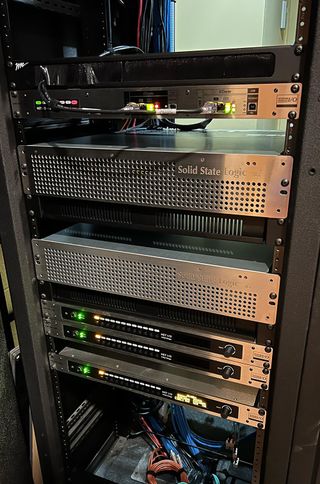Epic, a medical software supplier, has upgraded the audio mixing console in its multipurpose audio facility on its Wisconsin campus to a Solid State Logic System T platform. The new system is comprised of an S500 large-format modular mixing console and dual redundant TE2 Tempest Engines plus various Net I/O interfaces, including MADI Bridge units that handle a variety of broadcast, music production, and multimedia post production projects at the studio.
“This space is used as the broadcast facility for the meetings that take place in the auditorium," explained audiovisual media team leader Paul Micksch. "I record and broadcast to 15 countries. In addition to that, I run the media team here and do a lot of production and post production for our video media, including making music beds, and for any of the other audio and video media that we use.”
Founded in 1979, Epic is home to more than two dozen office and service buildings, a 65-room training center, a 5,800-seat auditorium, and the 11,400-capacity Deep Space auditorium, next to which is the audio studio. The Deep Space auditorium was built in 2013, at which time Epic installed an SSL C100 HD digital audio console, principally to broadcast software introductions and other events from the new venue. The studio, which has an attached live room, is also used to produce and post-produce media for those events and for Epic’s various products and platforms.
[Why Emerson College Turned to Solid State Logic in Broadcast Audio Upgrade]
“We try and offer information in an entertaining way, so we demonstrate software scenarios on stage and have a skit as part of our keynote executive address,” Micksch elaborated. “Our CEO will talk to gathered attendees and we put on a demonstration of various aspects of our software theatrically. That can have all sorts of sound effects and music cues.”

In his position at Epic, Micksch handles anything from audio capture through post production to broadcast mixing, plus location sound, sound design and recording, as well as composing and playing anything from pop to orchestral music. Previously, he would produce music at his home studio, but with the construction of the new auditorium and studio 10 years ago, he explained that the team made it a recording studio as well.
Micksch was so satisfied with the performance of Epic’s previous Solid State Logic console and with the company’s technical support that he jumped at the chance to install a System T when it came time to upgrade. He couldn’t be happier with the performance of SSL’s latest generation broadcast and music production platform.
“System T has really taken me into what feels like the next century of digital consoles,” he said. “The I/O count is great; I've got 192 channels that I can route, and I can set the console up in an extremely configurable way for how I mix the show. I can take individual channel counts from the unique presentations that we have in the main room, and I have a multi-viewer television on which I can monitor various feeds both from the presentation and from the cameras in the room. Then I can configure the System T however I need to for whatever the show might be and put things where I need to put them. And the touchscreen surface is just so flexible.”
[SCN Announces Pro AV Best in Market 2023 Award Winners]
Audio networking was still in an early stage of adoption when the auditorium and studio were built a decade ago, Micksch explained. Thus, the infrastructure was based on MADI. “I've gone Dante native, but we haven't updated the front-of-house console, so I'm still receiving MADI over multi-mode fiber and I have SSL MADI Bridges in the system here to convert to Dante,” he said of the new system.
While it would have been possible to mix for broadcast from the venue using a live sound console, the new studio space was built to meet the challenges of generating a sufficiently high-quality production from a large auditorium filled with thousands of people. “We decided that the mix for our recordings and to international folks should be produced in a different way," he recalled. Broadcast sound is very different from live sound, and I don't have the same battles in the studio, acoustically. and environmentally."











